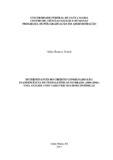| dc.creator | Schuh, Aline Beatriz | |
| dc.date.accessioned | 2018-10-10T17:55:13Z | |
| dc.date.available | 2018-10-10T17:55:13Z | |
| dc.date.issued | 2017-09-22 | |
| dc.identifier.uri | http://repositorio.ufsm.br/handle/1/14517 | |
| dc.description.abstract | The Payroll Loan is a relatively recent type of loan in the Brazilian credit market, and therefore the mechanisms of its concession and its effects on the default rate of individual clients are still rather unknown. In this sense, this study aims to verify the relationship between payroll loans and macroeconomic variables, such as the Gross Domestic Product (GDP), consumption, inflation rate, unemployment, and interest rate, as well as the relationship between these and the default rate in the personal loan portfolio, between 2004 and 2016. This was accomplished through bibliographical and documentary researches, and by using two Vector Error Correction models, which enabled the calculation of the impulse response functions, the variance decomposition and the Granger causality. The results showed that the payroll loan portfolio expanded significantly over the years and its concession reacts positively to changes in the GDP, and negatively to changes in consumption, unemployment, inflation and interest rates. In addition, it was also verified that the expansion of the payroll grating contributed to mitigate the context of default, since the estimates indicated negative long-term relationships between payroll and the default rate of individual clients. It was also observed that the most significant increases in the default rates coincided with moments of economic instability in Brazil, and this was confirmed by the econometric modeling, since the results showed that the default rate reacts negatively to variations in the GDP. On the other hand, the unemployment rate, the interest rate and inflation showed positive long-term relationships with the default rate in the personal loan portfolio, and for the consumption variable, the results were inconclusive. It is noteworthy that, except for the consumption index, all other relationships were in agreement with the literature and the expected behavior, confirming, therefore, that the macroeconomic scenario played an important role in the performance of the payroll portfolio in the period, and that this type of credit contributed to mitigate default rates. | eng |
| dc.language | por | por |
| dc.publisher | Universidade Federal de Santa Maria | por |
| dc.rights | Attribution-NonCommercial-NoDerivatives 4.0 International | * |
| dc.rights.uri | http://creativecommons.org/licenses/by-nc-nd/4.0/ | * |
| dc.subject | Crédito consignado | por |
| dc.subject | Variáveis macroeconômicas | por |
| dc.subject | Inadimplência | por |
| dc.subject | Vetor de correção de erros | por |
| dc.subject | Payroll loans | eng |
| dc.subject | Macroeconomic activity | eng |
| dc.subject | Default rate | eng |
| dc.subject | Vector error correction model | eng |
| dc.title | Determinantes do crédito consignado e da inadimplência de pessoas físicas no Brasil (2004-2016): uma análise com variáveis macroeconômicas | por |
| dc.title.alternative | Determinants of payroll loans and default rates of individual clients in Brazil (2004-2016): an analysis with macroeconomic variables | eng |
| dc.type | Dissertação | por |
| dc.description.resumo | O consignado é uma modalidade de empréstimo relativamente recente no mercado de crédito brasileiro e, por isso, os mecanismos de sua concessão e seus efeitos na inadimplência de pessoas físicas são ainda pouco conhecidos. Nesse sentido, este trabalho tem como objetivo investigar as relações existentes entre a concessão de crédito consignado e variáveis macroeconômicas selecionadas, como o Produto Interno Bruto (PIB), o consumo, a taxa de inflação, o desemprego e a taxa de juros, bem como a relação entre estes e a inadimplência de pessoas físicas entre 2004 e 2016. Fez-se isso por meio de levantamentos bibliográficos e documentais e mediante o emprego de dois modelos Vetoriais de Correção de Erros, que possibilitaram calcular as funções impulso-resposta, a decomposição da variância e a Causalidade de Granger. Os resultados apontam que a carteira do crédito consignado se expandiu significativamente ao longo dos anos, e sua concessão reagiu positivamente às variações no PIB, e negativamente ao consumo, ao desemprego, à inflação e à taxa de juros. Ademais, constatou-se também que a ampliação do consignado contribuiu para amenizar o contexto da inadimplência, já que as estimativas indicaram relações negativas, de longo prazo, entre o consignado e a inadimplência de pessoas físicas. Observou-se, ainda, que os aumentos mais expressivos da inadimplência de pessoas físicas coincidem com momentos de instabilidade econômica, e isso se confirmou por meio da modelagem econométrica, cujos resultados demonstraram que o índice de inadimplência de pessoas físicas reage negativamente às variações no PIB. Já a taxa de desemprego, a Selic e a inflação apresentaram relações positivas de longo prazo com o índice de inadimplência de pessoas físicas e, para a variável consumo, os resultados foram inconclusivos. Ressalta-se que, salvo o índice de consumo, todas as demais relações foram ao encontro da literatura e dos comportamentos esperados, confirmando, portanto, que o cenário macroeconômico atuou sobre o desempenho da carteira de consignado no período, e que este contribuiu para amenizar o nível de inadimplência de pessoas físicas. | por |
| dc.contributor.advisor1 | Marion Filho, Pascoal José | |
| dc.contributor.advisor1Lattes | http://lattes.cnpq.br/6357528016447284 | por |
| dc.contributor.referee1 | Coronel, Daniel Arruda | |
| dc.contributor.referee1Lattes | http://lattes.cnpq.br/9265604274170933 | por |
| dc.contributor.referee2 | Azevedo, André Filipe Zago de | |
| dc.contributor.referee2Lattes | http://lattes.cnpq.br/0625926234026025 | por |
| dc.creator.Lattes | http://lattes.cnpq.br/4289016881856523 | por |
| dc.publisher.country | Brasil | por |
| dc.publisher.department | Administração | por |
| dc.publisher.initials | UFSM | por |
| dc.publisher.program | Programa de Pós-Graduação em Administração | por |
| dc.subject.cnpq | CNPQ::CIENCIAS SOCIAIS APLICADAS::ADMINISTRACAO | por |
| dc.publisher.unidade | Centro de Ciências Sociais e Humanas | por |



